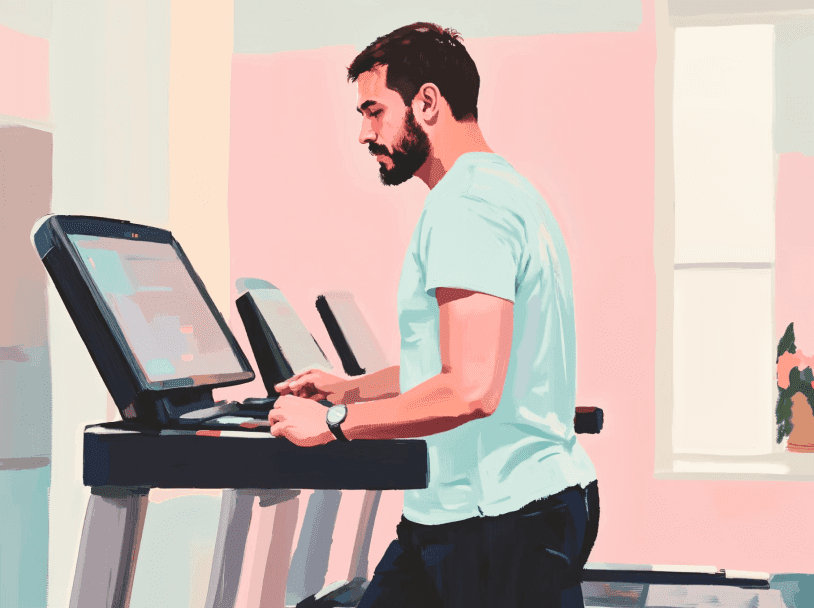First consultation?
Need a refill?
First consultation?
Need a refill?
The Importance of Flexibility and Mobility: A Key to Health and Well-being
6 mins
•
By
Eileen Quinones
• Feb 7, 2025
Flexibility and mobility are often overlooked aspects of fitness, yet they play a crucial role in overall health and well-being. Flexibility refers to the range of motion in muscles and connective tissues around a joint, while mobility is the ability to move freely and efficiently. Unlike other fitness components like strength or endurance, flexibility is highly specific to individual joints, making it a complex but essential element of physical fitness.
Research suggests that flexibility may contribute to health in various ways, including reducing the risk of injury, preventing back pain, and improving posture. However, despite its potential benefits, there is still limited large-scale evidence directly linking flexibility to overall health outcomes. Regardless, incorporating flexibility and mobility exercises into daily routines can enhance movement efficiency and quality of life.

Understanding Flexibility and Mobility
Flexibility is the ability of muscles and joints to move through their full range of motion. It is influenced by factors such as muscle length, joint structure, and connective tissue elasticity. Mobility, on the other hand, is the ability to control movement across joints, which involves a combination of flexibility, strength, and neuromuscular coordination.
There are different types of flexibility:²
Static flexibility: Holding a stretch for a prolonged period (e.g., touching your toes and holding the position).
Dynamic flexibility: Moving through a range of motion with controlled movements (e.g., leg swings or arm circles).
Active flexibility: Using muscles to move a joint without external assistance.
Passive flexibility: Using an external force, like gravity or a partner, to assist in a stretch.
Flexibility is often confused with mobility, but the key difference lies in control. Flexibility refers to how far a muscle can stretch, while mobility refers to how well the joint moves within its range. Good mobility requires strength, coordination, and flexibility.

Benefits of Flexibility and Mobility
While research on flexibility’s direct impact on health is ongoing, various studies suggest that improving flexibility and mobility can offer several benefits:¹
Injury Prevention: Flexible muscles are less prone to strains and tears, reducing the risk of injuries during physical activities.
Reduced Back Pain: Studies indicate that maintaining good flexibility, particularly in the lower back and hamstrings, may alleviate chronic back pain.
Improved Posture: Poor flexibility can lead to muscle imbalances, contributing to poor posture. Stretching and mobility exercises can help correct these imbalances.
Better Functional Movement: Enhanced mobility improves the ability to perform daily activities, such as bending, reaching, and walking with ease.
Enhanced Athletic Performance: Many sports and fitness activities require a good range of motion to optimize movement efficiency and prevent performance-related injuries.
Improved Blood Circulation: Stretching can enhance blood flow to muscles, reducing muscle fatigue and promoting faster recovery.
Reduced Risk of Falls: In older adults, maintaining mobility can prevent falls and improve balance, thereby promoting independence.
Flexibility and Mobility Training Techniques
To improve flexibility and mobility, a combination of different stretching and movement exercises should be included in a fitness routine. Some common techniques include:³
Static Stretching: Holding a stretch for 15-60 seconds to gradually increase muscle length. This type is beneficial post-exercise to enhance recovery.
Dynamic Stretching: Moving joints through their full range of motion to prepare muscles for activity. This is ideal before workouts or sports activities.
Proprioceptive Neuromuscular Facilitation (PNF): Alternating contraction and relaxation of muscles to increase flexibility. This technique is often used in physical therapy.
Foam Rolling (Self-Myofascial Release): Using a foam roller to release muscle tightness and improve tissue elasticity. This method helps reduce muscle stiffness and improve circulation.

Yoga and Tai Chi: These practices incorporate flexibility, balance, and strength training, promoting overall mobility.
Joint Mobility Drills: Specific exercises that improve movement efficiency, such as controlled articular rotations (CARs), which help strengthen joints through their full range of motion.
Common Flexibility and Mobility Tests

Assessing flexibility and mobility can help identify areas that need improvement. Common tests include:
Sit-and-Reach Test: Measures hamstring and lower back flexibility.
Shoulder Stretch Test: Evaluates shoulder mobility and flexibility.
Trunk Lift Test: Assesses back muscle strength and flexibility.
Overhead Squat Test: Determines mobility in the hips, knees, ankles, and shoulders.
Thomas Test: Evaluates hip flexor tightness, which can affect posture and movement.
Straight Leg Raise Test: Measures hamstring flexibility and lower back health.
Flexibility and Mobility Across Different Age Groups
Flexibility and mobility needs change with age. Younger individuals tend to be more flexible, while aging leads to a natural decline in joint mobility and muscle elasticity. However, regular stretching and mobility exercises can help mitigate these effects. Studies suggest that maintaining flexibility in older adults can aid in balance, reducing the risk of falls, and improving overall mobility for daily activities.⁴
Children and Adolescents: Young people generally have high flexibility. Encouraging mobility exercises helps develop coordination and movement efficiency.
Adults: Sedentary lifestyles can lead to stiffness and reduced mobility. Stretching and mobility work counteract these effects and improve daily function.
Seniors: Reduced joint mobility and muscle elasticity increase fall risk. Gentle stretching, yoga, and mobility drills help maintain independence and quality of life.
Tips for Improving Flexibility and Mobility
Here are some practical tips to enhance flexibility and mobility:
Consistency is Key: Stretching and mobility exercises should be done regularly to maintain and improve flexibility.
Warm Up Before Stretching: Never stretch cold muscles. Engage in light movement, like jogging or jumping jacks, before stretching.
Hold Stretches Properly: When doing static stretches, hold each stretch for at least 30 seconds to allow muscles to adapt.
Breathe Deeply: Deep breathing enhances relaxation and allows for deeper stretching.
Don’t Force It: Never push a stretch to the point of pain. Stretching should feel good, not painful.
Incorporate Movement: Static stretching alone isn’t enough—include dynamic movements and joint mobility drills.
Conclusion :
While flexibility may not be the sole determinant of health, it plays an essential role in movement, injury prevention, and overall physical function. Incorporating regular stretching and mobility exercises into your fitness routine can enhance posture, reduce muscle stiffness, and improve the quality of movement. Whether you’re an athlete, a fitness enthusiast, or simply looking to stay active as you age, prioritizing flexibility and mobility will contribute to long-term well-being and functional independence.
Understanding the importance of flexibility and mobility empowers individuals to take proactive steps toward better movement and health. By integrating effective stretching and mobility exercises, you can improve overall function, reduce pain, and enhance the quality of daily life.
Sources :
Committee on Fitness Measures and Health Outcomes in Youth; Food and Nutrition Board; Institute of Medicine; Pate R, Oria M, Pillsbury L, editors. Fitness Measures and Health Outcomes in Youth. Washington (DC): National Academies Press (US); 2012 Dec 10. 7, Health-Related Fitness Measures for Youth: Flexibility. Available from: https://www.ncbi.nlm.nih.gov/books/NBK241323/
Stathokostas L, Little RM, Vandervoort AA, Paterson DH. Flexibility training and functional ability in older adults: a systematic review. J Aging Res. 2012;2012:306818. doi: 10.1155/2012/306818. Epub 2012 Nov 8. PMID: 23209904; PMCID: PMC3503322.
Sexton, Patrick & Chambers, Jeffrey. (2006). The Importance of Flexibility for Functional Range of Motion. Athletic Therapy Today. 11. 13-17. 10.1123/att.11.3.13.
Harvard Health. (2024b, April 17). The importance of stretching. https://www.health.harvard.edu/staying-healthy/the-importance-of-stretching
Current version
Feb 7, 2025
Written by
Eileen Quinones (Nurse Practitioner)
Lose weight effectively
with GLP-1s
Complete our quick questionnaire to identify if you qualify. (approx 3 min)

Get meds delivered from
the comfort of your home.
Download our app now, and get amazing rewards!


The Importance of Flexibility and Mobility: A Key to Health and Well-being
6 mins
•
By
Eileen Quinones
• Feb 7, 2025
Flexibility and mobility are often overlooked aspects of fitness, yet they play a crucial role in overall health and well-being. Flexibility refers to the range of motion in muscles and connective tissues around a joint, while mobility is the ability to move freely and efficiently. Unlike other fitness components like strength or endurance, flexibility is highly specific to individual joints, making it a complex but essential element of physical fitness.
Research suggests that flexibility may contribute to health in various ways, including reducing the risk of injury, preventing back pain, and improving posture. However, despite its potential benefits, there is still limited large-scale evidence directly linking flexibility to overall health outcomes. Regardless, incorporating flexibility and mobility exercises into daily routines can enhance movement efficiency and quality of life.

Understanding Flexibility and Mobility
Flexibility is the ability of muscles and joints to move through their full range of motion. It is influenced by factors such as muscle length, joint structure, and connective tissue elasticity. Mobility, on the other hand, is the ability to control movement across joints, which involves a combination of flexibility, strength, and neuromuscular coordination.
There are different types of flexibility:²
Static flexibility: Holding a stretch for a prolonged period (e.g., touching your toes and holding the position).
Dynamic flexibility: Moving through a range of motion with controlled movements (e.g., leg swings or arm circles).
Active flexibility: Using muscles to move a joint without external assistance.
Passive flexibility: Using an external force, like gravity or a partner, to assist in a stretch.
Flexibility is often confused with mobility, but the key difference lies in control. Flexibility refers to how far a muscle can stretch, while mobility refers to how well the joint moves within its range. Good mobility requires strength, coordination, and flexibility.

Benefits of Flexibility and Mobility
While research on flexibility’s direct impact on health is ongoing, various studies suggest that improving flexibility and mobility can offer several benefits:¹
Injury Prevention: Flexible muscles are less prone to strains and tears, reducing the risk of injuries during physical activities.
Reduced Back Pain: Studies indicate that maintaining good flexibility, particularly in the lower back and hamstrings, may alleviate chronic back pain.
Improved Posture: Poor flexibility can lead to muscle imbalances, contributing to poor posture. Stretching and mobility exercises can help correct these imbalances.
Better Functional Movement: Enhanced mobility improves the ability to perform daily activities, such as bending, reaching, and walking with ease.
Enhanced Athletic Performance: Many sports and fitness activities require a good range of motion to optimize movement efficiency and prevent performance-related injuries.
Improved Blood Circulation: Stretching can enhance blood flow to muscles, reducing muscle fatigue and promoting faster recovery.
Reduced Risk of Falls: In older adults, maintaining mobility can prevent falls and improve balance, thereby promoting independence.
Flexibility and Mobility Training Techniques
To improve flexibility and mobility, a combination of different stretching and movement exercises should be included in a fitness routine. Some common techniques include:³
Static Stretching: Holding a stretch for 15-60 seconds to gradually increase muscle length. This type is beneficial post-exercise to enhance recovery.
Dynamic Stretching: Moving joints through their full range of motion to prepare muscles for activity. This is ideal before workouts or sports activities.
Proprioceptive Neuromuscular Facilitation (PNF): Alternating contraction and relaxation of muscles to increase flexibility. This technique is often used in physical therapy.
Foam Rolling (Self-Myofascial Release): Using a foam roller to release muscle tightness and improve tissue elasticity. This method helps reduce muscle stiffness and improve circulation.

Yoga and Tai Chi: These practices incorporate flexibility, balance, and strength training, promoting overall mobility.
Joint Mobility Drills: Specific exercises that improve movement efficiency, such as controlled articular rotations (CARs), which help strengthen joints through their full range of motion.
Common Flexibility and Mobility Tests

Assessing flexibility and mobility can help identify areas that need improvement. Common tests include:
Sit-and-Reach Test: Measures hamstring and lower back flexibility.
Shoulder Stretch Test: Evaluates shoulder mobility and flexibility.
Trunk Lift Test: Assesses back muscle strength and flexibility.
Overhead Squat Test: Determines mobility in the hips, knees, ankles, and shoulders.
Thomas Test: Evaluates hip flexor tightness, which can affect posture and movement.
Straight Leg Raise Test: Measures hamstring flexibility and lower back health.
Flexibility and Mobility Across Different Age Groups
Flexibility and mobility needs change with age. Younger individuals tend to be more flexible, while aging leads to a natural decline in joint mobility and muscle elasticity. However, regular stretching and mobility exercises can help mitigate these effects. Studies suggest that maintaining flexibility in older adults can aid in balance, reducing the risk of falls, and improving overall mobility for daily activities.⁴
Children and Adolescents: Young people generally have high flexibility. Encouraging mobility exercises helps develop coordination and movement efficiency.
Adults: Sedentary lifestyles can lead to stiffness and reduced mobility. Stretching and mobility work counteract these effects and improve daily function.
Seniors: Reduced joint mobility and muscle elasticity increase fall risk. Gentle stretching, yoga, and mobility drills help maintain independence and quality of life.
Tips for Improving Flexibility and Mobility
Here are some practical tips to enhance flexibility and mobility:
Consistency is Key: Stretching and mobility exercises should be done regularly to maintain and improve flexibility.
Warm Up Before Stretching: Never stretch cold muscles. Engage in light movement, like jogging or jumping jacks, before stretching.
Hold Stretches Properly: When doing static stretches, hold each stretch for at least 30 seconds to allow muscles to adapt.
Breathe Deeply: Deep breathing enhances relaxation and allows for deeper stretching.
Don’t Force It: Never push a stretch to the point of pain. Stretching should feel good, not painful.
Incorporate Movement: Static stretching alone isn’t enough—include dynamic movements and joint mobility drills.
Conclusion :
While flexibility may not be the sole determinant of health, it plays an essential role in movement, injury prevention, and overall physical function. Incorporating regular stretching and mobility exercises into your fitness routine can enhance posture, reduce muscle stiffness, and improve the quality of movement. Whether you’re an athlete, a fitness enthusiast, or simply looking to stay active as you age, prioritizing flexibility and mobility will contribute to long-term well-being and functional independence.
Understanding the importance of flexibility and mobility empowers individuals to take proactive steps toward better movement and health. By integrating effective stretching and mobility exercises, you can improve overall function, reduce pain, and enhance the quality of daily life.
Current version
Feb 7, 2025
Written by
Eileen Quinones (Nurse Practitioner)
Fact checked by
Sources :
Committee on Fitness Measures and Health Outcomes in Youth; Food and Nutrition Board; Institute of Medicine; Pate R, Oria M, Pillsbury L, editors. Fitness Measures and Health Outcomes in Youth. Washington (DC): National Academies Press (US); 2012 Dec 10. 7, Health-Related Fitness Measures for Youth: Flexibility. Available from: https://www.ncbi.nlm.nih.gov/books/NBK241323/
Stathokostas L, Little RM, Vandervoort AA, Paterson DH. Flexibility training and functional ability in older adults: a systematic review. J Aging Res. 2012;2012:306818. doi: 10.1155/2012/306818. Epub 2012 Nov 8. PMID: 23209904; PMCID: PMC3503322.
Sexton, Patrick & Chambers, Jeffrey. (2006). The Importance of Flexibility for Functional Range of Motion. Athletic Therapy Today. 11. 13-17. 10.1123/att.11.3.13.
Harvard Health. (2024b, April 17). The importance of stretching. https://www.health.harvard.edu/staying-healthy/the-importance-of-stretching
Similar Health Guides

The Importance of Flexibility and Mobility: A Key to Health and Well-being
6 mins


Intermittent Fasting: Health Benefits, Weight Loss Tips, and How to Get Started


Ketogenic Diet: Benefits, Tips, and How to Start a Keto Journey
6 mins


Mixing Strength Training and Cardiovascular Exercise: A Comprehensive Guide
6 mins


The Importance of Flexibility and Mobility: A Key to Health and Well-being
6 mins


Intermittent Fasting: Health Benefits, Weight Loss Tips, and How to Get Started


Ketogenic Diet: Benefits, Tips, and How to Start a Keto Journey
6 mins


Mixing Strength Training and Cardiovascular Exercise: A Comprehensive Guide
6 mins


The Importance of Flexibility and Mobility: A Key to Health and Well-being
6 mins


Intermittent Fasting: Health Benefits, Weight Loss Tips, and How to Get Started


Ketogenic Diet: Benefits, Tips, and How to Start a Keto Journey
6 mins


Mixing Strength Training and Cardiovascular Exercise: A Comprehensive Guide
6 mins


The Importance of Flexibility and Mobility: A Key to Health and Well-being
6 mins


Intermittent Fasting: Health Benefits, Weight Loss Tips, and How to Get Started


Ketogenic Diet: Benefits, Tips, and How to Start a Keto Journey
6 mins


Mixing Strength Training and Cardiovascular Exercise: A Comprehensive Guide
6 mins

Lose weight effectively
with GLP-1s
Complete our quick questionnaire to identify if you qualify. (approx 3 min)

Lose weight effectively
with GLP-1s
Complete our quick questionnaire to identify if you qualify. (approx 3 min)
